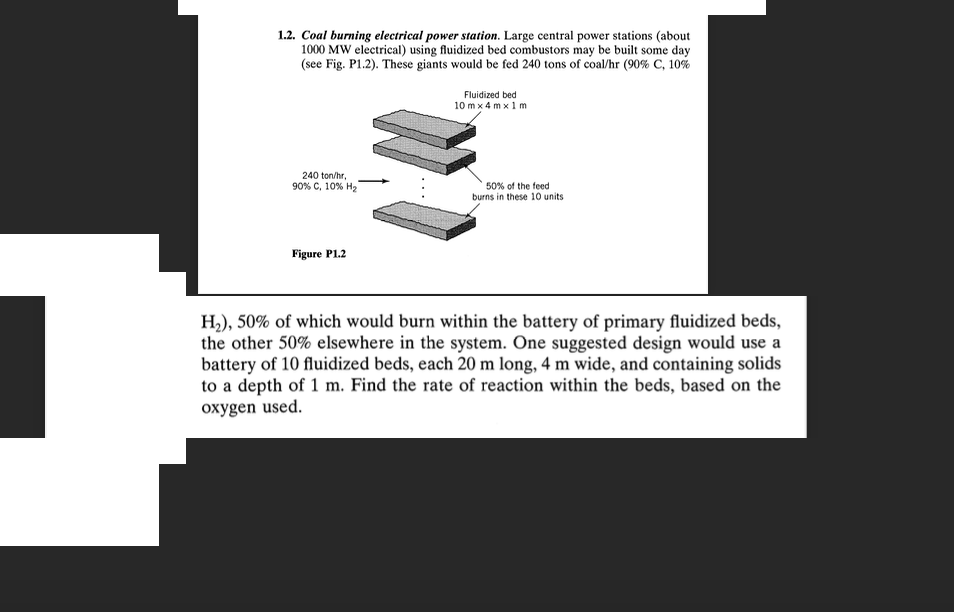1.2. Coal burning electrical power station. Large central power stations (about 1000 MW electrical) using fluidized bed combustors may be built some day (see Fig. P1.2). These giants would be fed 240 tons of coal/hr (90% C, 10% Fluidized bed 10m x 4mx 1 m 240 ton/hr, 90% C, 10% H2 50% of the feed burns in these 10 units Figure P1.2 H2), 50% of which would burn within the battery of primary fluidized beds, the other 50% elsewhere in the system. One suggested design would use a battery of 10 fluidized beds, each 20 m long, 4 m wide, and containing solids to a depth of 1 m. Find the rate of reaction within the beds, based on the oxygen used.
1.2. Coal burning electrical power station. Large central power stations (about 1000 MW electrical) using fluidized bed combustors may be built some day (see Fig. P1.2). These giants would be fed 240 tons of coal/hr (90% C, 10% Fluidized bed 10m x 4mx 1 m 240 ton/hr, 90% C, 10% H2 50% of the feed burns in these 10 units Figure P1.2 H2), 50% of which would burn within the battery of primary fluidized beds, the other 50% elsewhere in the system. One suggested design would use a battery of 10 fluidized beds, each 20 m long, 4 m wide, and containing solids to a depth of 1 m. Find the rate of reaction within the beds, based on the oxygen used.
Introduction to Chemical Engineering Thermodynamics
8th Edition
ISBN:9781259696527
Author:J.M. Smith Termodinamica en ingenieria quimica, Hendrick C Van Ness, Michael Abbott, Mark Swihart
Publisher:J.M. Smith Termodinamica en ingenieria quimica, Hendrick C Van Ness, Michael Abbott, Mark Swihart
Chapter1: Introduction
Section: Chapter Questions
Problem 1.1P
Related questions
Question

Transcribed Image Text:1.2. Coal burning electrical power station. Large central power stations (about
1000 MW electrical) using fluidized bed combustors may be built some day
(see Fig. P1.2). These giants would be fed 240 tons of coal/hr (90% C, 10%
Fluidized bed
10m x 4mx 1 m
240 ton/hr,
90% C, 10% H2
50% of the feed
burns in these 10 units
Figure P1.2
H2), 50% of which would burn within the battery of primary fluidized beds,
the other 50% elsewhere in the system. One suggested design would use a
battery of 10 fluidized beds, each 20 m long, 4 m wide, and containing solids
to a depth of 1 m. Find the rate of reaction within the beds, based on the
oxygen used.
Expert Solution
This question has been solved!
Explore an expertly crafted, step-by-step solution for a thorough understanding of key concepts.
Step by step
Solved in 2 steps with 3 images

Recommended textbooks for you

Introduction to Chemical Engineering Thermodynami…
Chemical Engineering
ISBN:
9781259696527
Author:
J.M. Smith Termodinamica en ingenieria quimica, Hendrick C Van Ness, Michael Abbott, Mark Swihart
Publisher:
McGraw-Hill Education

Elementary Principles of Chemical Processes, Bind…
Chemical Engineering
ISBN:
9781118431221
Author:
Richard M. Felder, Ronald W. Rousseau, Lisa G. Bullard
Publisher:
WILEY

Elements of Chemical Reaction Engineering (5th Ed…
Chemical Engineering
ISBN:
9780133887518
Author:
H. Scott Fogler
Publisher:
Prentice Hall

Introduction to Chemical Engineering Thermodynami…
Chemical Engineering
ISBN:
9781259696527
Author:
J.M. Smith Termodinamica en ingenieria quimica, Hendrick C Van Ness, Michael Abbott, Mark Swihart
Publisher:
McGraw-Hill Education

Elementary Principles of Chemical Processes, Bind…
Chemical Engineering
ISBN:
9781118431221
Author:
Richard M. Felder, Ronald W. Rousseau, Lisa G. Bullard
Publisher:
WILEY

Elements of Chemical Reaction Engineering (5th Ed…
Chemical Engineering
ISBN:
9780133887518
Author:
H. Scott Fogler
Publisher:
Prentice Hall


Industrial Plastics: Theory and Applications
Chemical Engineering
ISBN:
9781285061238
Author:
Lokensgard, Erik
Publisher:
Delmar Cengage Learning

Unit Operations of Chemical Engineering
Chemical Engineering
ISBN:
9780072848236
Author:
Warren McCabe, Julian C. Smith, Peter Harriott
Publisher:
McGraw-Hill Companies, The